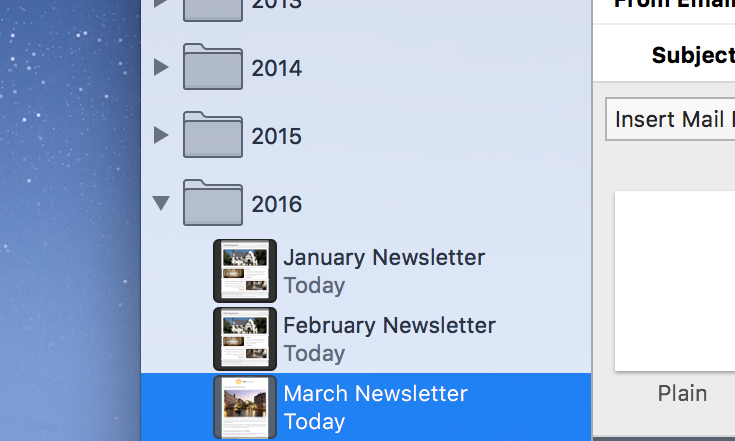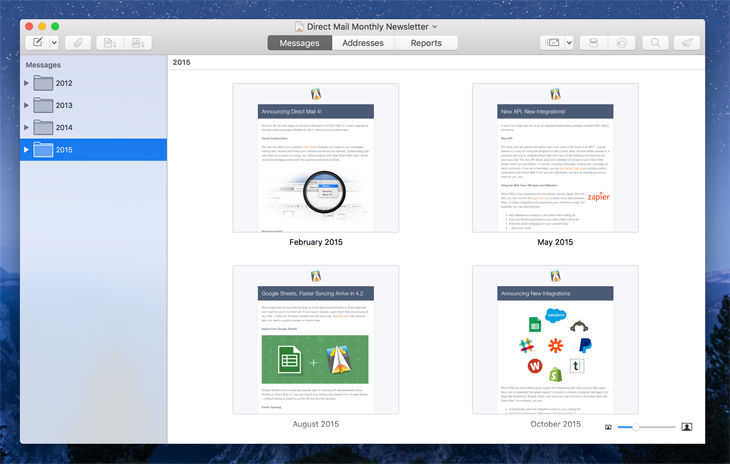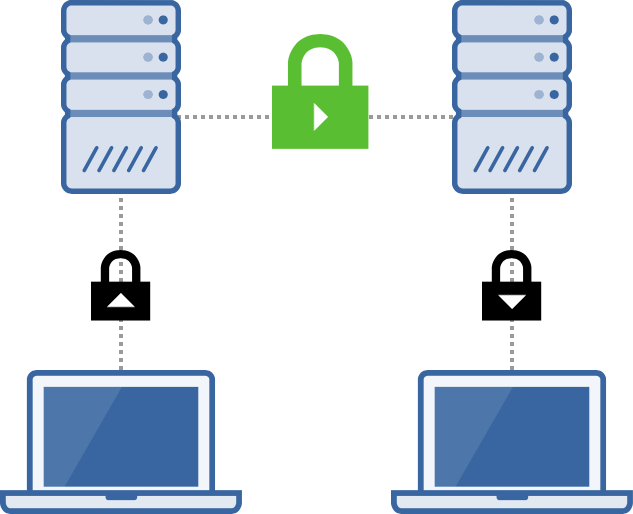We have some shiny new bits available for you to download today. Our version 4.3 update includes oft-requested new features as well as enhancements to existing features, like autoresponders, that make them even easier to use. Here are some of the highlights of what’s new and improved (or you can read the release notes for the details).
Folders!
Your messages and autoresponders can now be organized into folders. This is one of the most frequently requested features, and it’s easy to see why. If you have a long list of messages that you feel are cluttering up your project, use message folders to keep them nice and organized. Likewise, use autoresponder folders to keep your various automated campaigns organized and under control.

If you select a folder in your source list, you’ll see a handy grid view of all the messages and folders contained therein (double-click the thumbnail to jump right to the message for editing).

Contacts Syncing
Direct Mail has always supported importing contacts from your OS X Contacts app. Now you can sync your OS X Contacts to an address group in Direct Mail with just one click. Direct Mail will take care of updating contacts that have changed, as well as syncing unsubscribe information back to the Contacts app. This feature also works with the older “Address Book” in OS X 10.7.
Autoresponder Sequences

Campaign automation was one of the big new features to arrive in Direct Mail 4. This update builds on that foundation to make autoresponders even more useful and easier to use. The first improvement is that autoresponders can now be triggered by previous autoresponder emails. For example, you may want to create a three-week email training course that people can subscribe to online (one email per week). Here’s how to do that:
- Create three autoresponders: Week 1, Week 2, and Week 3
- The Week 1 email is triggered when a person subscribes to your course using a Direct Mail subscribe form
- The Week 2 email is triggered seven days after the Week 1 email
- The Week 3 email is triggered seven days after the Week 2 email
Look for the new “Trigger after another autoresponder” option in the Autoresponders window.
Another improvement is that autoresponder emails can now be triggered manually. In our above example, you may have a friend who did not fill out the subscribe form, but that asked to be added to your training course. To enroll that person in the email course, simply add their email address to your list in Direct Mail, then choose Addresses > Trigger Autoresponder from the menu bar at the top of your screen. Your friend will now begin receiving your email course.
Additional Improvements
The release notes contain more detail, but this release includes a host of other improvements and bug fixes including:
- A new, modern look for the Autoresponder, Design Test, and Spam Test windows
- Design Test results can now be sorted by popularity, and results appear more quickly
- Mail-merge tags can now be safely used inside URLs (see the release notes or help documentation for detail)
How to Upgrade
Upgrading is easy (and free)! Just open up the Direct Mail app and choose Direct Mail > Check for Software Update from the menu bar at the top of your screen. Mac App Store customers will receive the upgrade automatically in a few weeks once Apple has approved the update. Update: Apple has now approved the update.
Thank you to all our customers that have provided and continue to provide feedback on Direct Mail. We are excited to bring these improvements to you today, and look forward to the next round of great new features coming soon! Got an idea in mind? Please get in touch!
